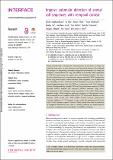Files in this item
Improve automatic detection of animal call sequences with temporal context
Item metadata
| dc.contributor.author | Madhusudhana, Shyam | |
| dc.contributor.author | Shiu, Yu | |
| dc.contributor.author | Klinck, Holger | |
| dc.contributor.author | Fleishman, Erica | |
| dc.contributor.author | Liu, Xiaobai | |
| dc.contributor.author | Nosal, Eva-Marie | |
| dc.contributor.author | Helble, Tyler | |
| dc.contributor.author | Cholewiak, Danielle | |
| dc.contributor.author | Gillespie, Douglas | |
| dc.contributor.author | Širović, Ana | |
| dc.contributor.author | Roch, Marie A | |
| dc.date.accessioned | 2021-07-28T09:30:08Z | |
| dc.date.available | 2021-07-28T09:30:08Z | |
| dc.date.issued | 2021-07 | |
| dc.identifier | 275214157 | |
| dc.identifier | c9f003f8-148c-47fb-acb7-f60b29de85d4 | |
| dc.identifier | 000676307900001 | |
| dc.identifier | 85111982081 | |
| dc.identifier.citation | Madhusudhana , S , Shiu , Y , Klinck , H , Fleishman , E , Liu , X , Nosal , E-M , Helble , T , Cholewiak , D , Gillespie , D , Širović , A & Roch , M A 2021 , ' Improve automatic detection of animal call sequences with temporal context ' , Journal of the Royal Society Interface , vol. 18 , no. 180 , 20210297 . https://doi.org/10.1098/rsif.2021.0297 | en |
| dc.identifier.issn | 1742-5662 | |
| dc.identifier.other | RIS: urn:749B5F2AA55940CFE3965339CA37091E | |
| dc.identifier.other | ORCID: /0000-0001-9628-157X/work/97884665 | |
| dc.identifier.uri | https://hdl.handle.net/10023/23659 | |
| dc.description | Funding: This work was supported by the US Office of Naval Research (grant no. N00014-17-1-2867). | en |
| dc.description.abstract | Many animals rely on long-form communication, in the form of songs, for vital functions such as mate attraction and territorial defence. We explored the prospect of improving automatic recognition performance by using the temporal context inherent in song. The ability to accurately detect sequences of calls has implications for conservation and biological studies. We show that the performance of a convolutional neural network (CNN), designed to detect song notes (calls) in short-duration audio segments, can be improved by combining it with a recurrent network designed to process sequences of learned representations from the CNN on a longer time scale. The combined system of independently trained CNN and long short-term memory (LSTM) network models exploits the temporal patterns between song notes. We demonstrate the technique using recordings of fin whale (Balaenoptera physalus) songs, which comprise patterned sequences of characteristic notes. We evaluated several variants of the CNN + LSTM network. Relative to the baseline CNN model, the CNN + LSTM models reduced performance variance, offering a 9-17% increase in area under the precision-recall curve and a 9-18% increase in peak F1-scores. These results show that the inclusion of temporal information may offer a valuable pathway for improving the automatic recognition and transcription of wildlife recordings. | |
| dc.format.extent | 13 | |
| dc.format.extent | 3249808 | |
| dc.language.iso | eng | |
| dc.relation.ispartof | Journal of the Royal Society Interface | en |
| dc.subject | Bioacoustics | en |
| dc.subject | Improved performance | en |
| dc.subject | Machine learning | en |
| dc.subject | Passive acoustic monitoring | en |
| dc.subject | Robust automatic recognition | en |
| dc.subject | Temporal context | en |
| dc.subject | QA76 Computer software | en |
| dc.subject | QH301 Biology | en |
| dc.subject | DAS | en |
| dc.subject.lcc | QA76 | en |
| dc.subject.lcc | QH301 | en |
| dc.title | Improve automatic detection of animal call sequences with temporal context | en |
| dc.type | Journal article | en |
| dc.contributor.institution | University of St Andrews. School of Biology | en |
| dc.contributor.institution | University of St Andrews. Sea Mammal Research Unit | en |
| dc.contributor.institution | University of St Andrews. Scottish Oceans Institute | en |
| dc.contributor.institution | University of St Andrews. Sound Tags Group | en |
| dc.contributor.institution | University of St Andrews. Bioacoustics group | en |
| dc.contributor.institution | University of St Andrews. Marine Alliance for Science & Technology Scotland | en |
| dc.identifier.doi | https://doi.org/10.1098/rsif.2021.0297 | |
| dc.description.status | Peer reviewed | en |
This item appears in the following Collection(s)
Items in the St Andrews Research Repository are protected by copyright, with all rights reserved, unless otherwise indicated.

